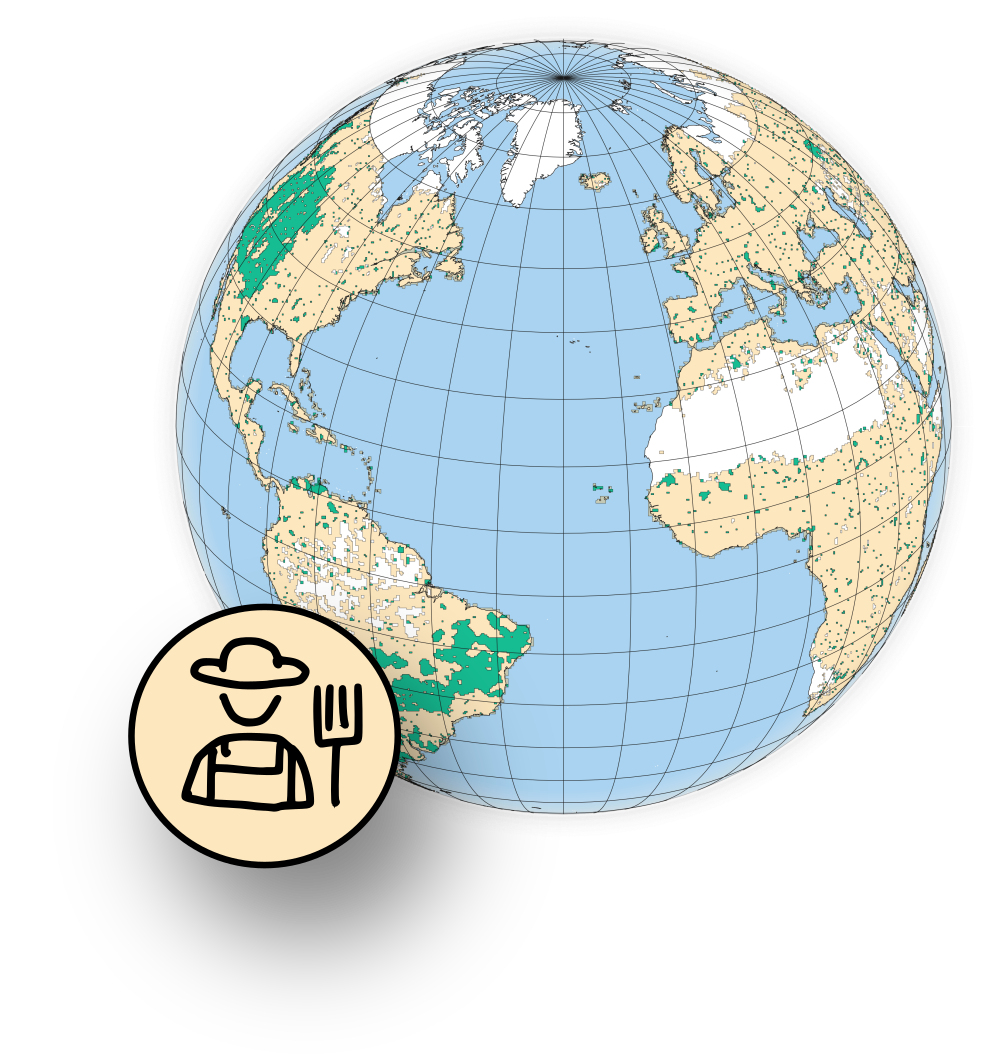From farm to planet: InSEEDS is the first model to simulate the coevolution of societies and ecosystems at the global scale.

🚀 A New Generation of Modelling
InSEEDS is a next-generation modelling approach for simulating land-based
natural processes in direct interaction with humans and societies described in
Schwarz et al., 2025.
Its focus: exploring regenerative future pathways for food systems and beyond.
Unlike traditional Integrated Assessment Models (IAMs), InSEEDS combines:
✨ Detailed biosphere processes (e.g. nitrogen fixation, tillage practices)
🤝 Active human or AI agents, representing real-world decisions and behaviours
This unique integration opens up new research on social tipping, resilience, and coevolution between people and ecosystems.
📖 Read more
In contrast to existing modelling approaches, such as traditional IAMs, InSEEDS integrates a process-detailed representation of the terrestrial biosphere. This enables it to simulate specific mechanisms like biological nitrogen fixation or assess regenerative farming practices that have never before been explored at a global scale.
But the true innovation lies not only in process detail — it is the inclusion of humans and societies as active agents. Building on advances in social science, InSEEDS models human decision-making and behaviour in unprecedented detail.
🌱 Need for Regenerative Pathways
Our planet faces unprecedented Earth system destabilization through the transgression of multiple planetary boundaries. Agriculture is both a major driver of this crisis and increasingly vulnerable to its consequences:
🚨 Current Crisis:
⚠️ 25% of GHG emissions stem from agriculture
⚠️ Land degradation drives biodiversity loss
⚠️ Freshwater use and biogeochemical flows exceed safe limits
⚠️ Feeding 10 billion people by 2050 requires fundamental transformations (Gerten et al., 2020)
🌍 Regenerative agriculture as part of the great turnaround:
✅ Climate resilience & yield stability (WEF, 2024)
✅ Soil as a carbon sink - helping return within planetary boundaries
✅ Enhanced water retention & biodiversity restoration (Schreefel et al., 2020)
✅ Multi-benefit solutions that address multiple planetary boundaries simultaneously (Rockström et al., 2024)
📖 Read more
The transgression of multiple planetary boundaries represents a fundamental challenge to Earth system stability (Rockström et al., 2024). Agriculture is a key driver across several boundaries: climate change (25% of GHG emissions), land-system change, freshwater use, biogeochemical flows (nitrogen/phosphorus), and biosphere integrity (biodiversity loss).
Regenerative agriculture offers a “great turnaround” by addressing multiple planetary boundaries simultaneously: creating carbon sinks through soil restoration, reducing water consumption, minimizing chemical inputs, and enhancing biodiversity (Rockström et al., 2024). This multi-benefit approach is essential for achieving the transformations needed to feed 10 billion people while returning within safe planetary boundaries.
Researching both the potential and realistic pathways for these transformations is critical for success. InSEEDS provides the tools to simulate and understand these complex social-ecological dynamics.
👉 But how can such a transition play out globally?
That’s what InSEEDS is designed to explore.
🔄 Coevolutionary Modelling
A global shift to regenerative agriculture involves complex social-ecological systems, where human decisions interact with biophysical processes and feedbacks.
Traditional IAMs cannot capture these dynamics, they …
❌ Do not capture detailed biogeophysical processes
❌ Do not include endogenous societal interactions
❌ Fail to represent coevolutionary mechanisms
📖 Read more
Right now, we lack a clear understanding of how a global transition to regenerative agriculture could unfold. Such a transformation involves complex social-ecological systems, where human decisions interact with biophysical processes and feedbacks across scales and timeframes (Donges et al., 2017).
This interdependence is the foundation of the coevolutionary potential of regenerative pathways. InSEEDS makes it possible to simulate these pathways and explore associated dynamics such as social tipping points, long-term benefits for societies, and climate resilience.
🌱 InSEEDS is the first model able to simulate coevolutionary pathways,
capturing feedbacks between societies and ecosystems — opening new research on social tipping points and climate resilience.
⏳ The Frontier
The next decade is a critical window to scale regenerative agriculture.
With InSEEDS, we aim to show what pathways are possible, how societies and
ecosystems could coevolve, and what opportunities will emerge.
This way we want to shape the scientific and political discourse on the
future of food.
📖 Read more
Regenerative agriculture could become a paradigm that reshapes the future of food and land management.
InSEEDS provides a tool to test, compare, and explore pathways toward this future.
By doing so, we aim to influence both scientific exploration and policy debates on sustainable agriculture and food systems.
🤝 Join us
We are looking for:
- Project partners to push the science of social-ecological transitions
- Funders to scale this work and explore real-world applications
- Collaborators to connect InSEEDS with policy and practice
📩 Contact us: breier@pik-potsdam.de
📚 References
- Donges, J. F. et al. (2017). Closing the loop: Reconnecting human dynamics to Earth System science. The Anthropocene Review, 4(2), 151-157. https://doi.org/10.1177/2053019617725537
- Gerten, D., et al. (2020). Feeding ten billion people is possible within four terrestrial planetary boundaries. Nature Sustainability, 3(3), 200-208. https://doi.org/10.1038/s41893-019-0465-1
- Rockström, J., Donges, J. F., Fetzer, I., Martin, M. A., Wang-Erlandsson, L., & Richardson, K. (2024). Planetary Boundaries guide humanity’s future on Earth. Nature Reviews Earth & Environment, 5, 773-788. https://doi.org/10.1038/s43017-024-00597-z
- Schreefel, L., et al. (2020). Regenerative agriculture – the soil is the base. Global Food Security, 26, 100404. https://doi.org/10.1016/j.gfs.2020.100404
- Schwarz, L., Breier, J. et al. (2025). From Farm to Planet: The InSEEDS World-Earth Model for Simulating Transitions to Regenerative Agriculture. EGUsphere [preprint]. https://doi.org/10.5194/egusphere-2025-4079
- WEF (2024). Regenerative agriculture: Climate solutions for resilient food systems. World Economic Forum. https://www.weforum.org/stories/2024/11/regenerative-agriculture-climate-solutions-resilient/